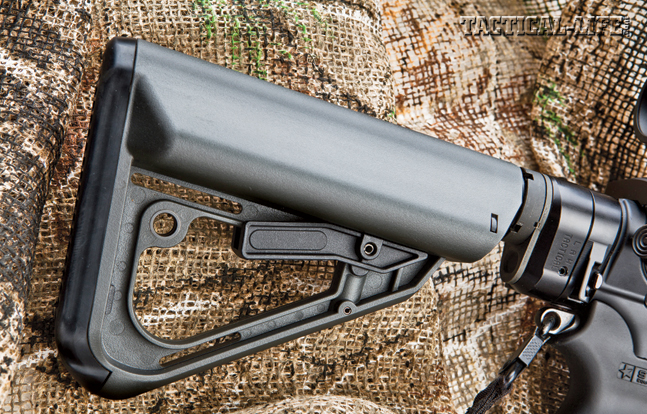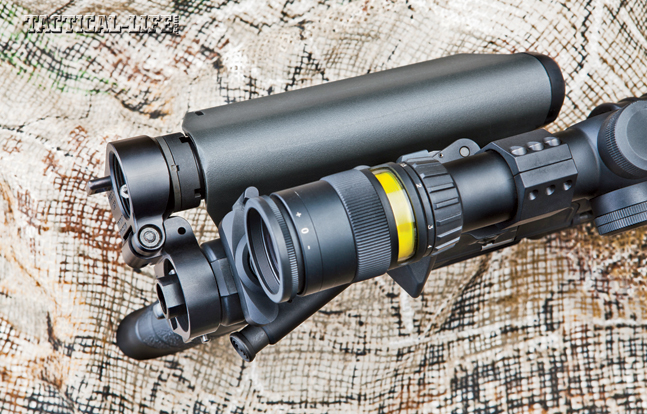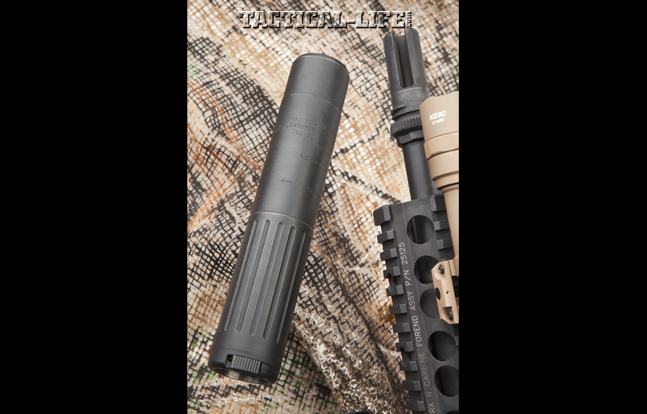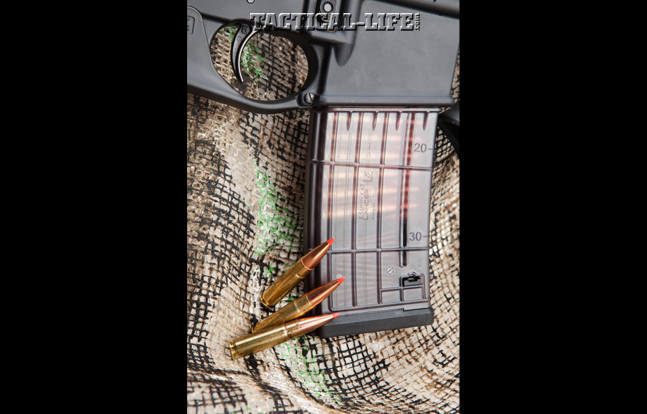It’s hard to keep track of the number of rounds I have fired of the recently-popular 300 AAC Blackout cartridge and its older twin, the .300 Whisper, over the last few years. Most of the rounds fired—easily over 5,000—have been at targets, but the body counts for deer, feral hogs and coyotes is now well past the 100 mark.
Typically, killing more than 120 game animals with a single cartridge takes decades, but that wasn’t the case when I got invited to a Trijicon-sponsored airborne hunt in Texas last spring. I got the choice of using a 5.56mm AR or one of my favorites, an Advanced Armament Corporation (AAC) short-barreled AR in 300 BLK. Since I’m such a big fan of the “little .30,” it wasn’t too hard of a decision.
More than a year in the making, I wanted to match up one of AAC’s 9-inch-barreled, 300 BLK-chambered MPW uppers with a registered SBR lower to create one of my all-time favorite rigs. In this case, the lower receiver is a Bravo Company Manufacturing (BCM) unit that I’ve fitted with a Geissele two-stage trigger. After sliding on an EXOS Defense Ti-7 collapsible buttstock, this little rig is not only handy, but it packs a decent punch—a magazine full, to be precise.
Advertisement — Continue Reading Below
Click here to watch a video of the airborne hog hunt!
Continue Reading: Airborne Hog Hunt | AAC MPW .300 BLK Upper & BCM Lower | VIDEO

Airing Things Out
Advertisement — Continue Reading Below
The setting for the Trijicon hunt was in the wind-swept plains and sand hills near Lubbock, Texas. Local farmers were preparing their fields to plant tens of thousands of acres of peanuts, and it was time to hammer the feral hog population so they would have a chance to reap a decent crop.
By now, most hunters know that feral hogs are at near-plague numbers in many states across the nation. Texas seems to have a truly epic hog population, and it welcomes anyone with a porcine itch to scratch. Now, I love to hunt hogs like I do whitetails, with most any weapon from a blind or elevated stand. Spot-and-stalk hunts are fun, too. But, when the order of the day is to turn as many wild hogs into buzzard bait and coyote poop as possible, a helicopter is the most efficient method of assault.
It’s been more than a decade, but I’ve made airborne eradication flights in Texas before last spring. Prior to the hunt, I got in touch with helicopter pilot Kyle Lange to learn more about his operation. Small world that it is, I pieced together the fact that I had previously coyote hunted with his father on a ranch near Abilene that nearly had its whitetail population wiped out by coyotes. We cleaned up the 5,500-acre ranch, and I was able to hammer 18 coyotes in 75 minutes of flying time with a short-barreled, 12-gauge turkey gun and buckshot. This time we’d be using rifles to clean up coyotes and make a pile of 300 BLK bacon.
Advertisement — Continue Reading Below
“My hit ratio was so good because of some pre-hunt preparation as well as choosing the right rifle/optic combination.”
On the first flight late in the afternoon, we flew for more than 30 minutes over an expanse of sand hills. We only saw mule deer until we found an old, overgrown house site. Cover was scarce, but a clump of tall grass merely one-fifth an acre in size warranted a closer look. As we buzzed in, a lone shoat stood in what had been the front yard of the abandoned sharecropper shack. Kyle keyed his mic and stated that if there was one little piggy, there had to be more. When the rotor wash hit the grass patch, out squirted one little piggy, two little piggies, three little piggies and so on until eight shoats lined out, heading east. We nearly mashed the grass flat with the rotor wash when big momma and a girlfriend got in gear, too.
Eager to squeeze the trigger, Kyle told me to wait until we chased them into more open terrain, and to shoot from the back of the herd to the front. That way, the hogs wouldn’t see their mates fall and would keep running in a single-file line. The biggest sow was the rearmost of the herd, so it was an easy choice. Expecting to need to put several rounds through the lumbering 200-plus-pound hog, I was pleasantly surprised when a 110-grain Barnes hit her at about 2,200 fps in the spine, right between the shoulders, and she skidded to a quivering stop.
The first hog seemed too easy, so I aimed carefully and waited to match the chopper’s speed with that of the next hog before I broke the shot. Two shots and two dead hogs—I was getting a big head. That didn’t last long, with the next three shots requiring more reverse lead than I had allowed as we zoomed over the wad of pork. Circling back, I found target after target, hitting more than I missed. Before we knew it, all 10 peanut-eaters were converted to fertilizer.
Advertisement — Continue Reading Below
Over the next couple of days, I made four more successful flights in search of hogs and other farm-wrecking vermin. I burned through about 220 rounds of ammo, which was much better than I had anticipated. My hit ratio was so good because of some pre-hunt preparation as well as choosing the right rifle/optic combination. I opted for a Trijicon 1-4×24 AccuPoint scope with a reticle sporting a heavy post tipped with a solid amber triangle. When cranked down to 1X, it offers a wide field of view and shoots well with both eyes open for fast target acquisition.
Typically, I sight this scope so that the point of the amber-triangle reticle is dead on at 100 yards, but for this hunt I made some changes. I adjusted the reticle so that the center of the amber triangle covered the point of impact at 40 yards. That way, whenever I painted moving targets with the triangle, that’s where the bullets struck—usually. Whenever I had to adjust my lead based upon the helicopter’s speed and angle of approach, as well as the direction of a running quarry, shots could get kind of tricky. It didn’t take me long to get the hang of it. Most times I waited until I got the shot I wanted instead of spraying and praying. That helped keep my hit ratio hovering around 50 percent. All told, I killed just over 50 hogs with this setup before the hunt was over.
Continue Reading: Airborne Hog Hunt | AAC MPW .300 BLK Upper & BCM Lower | VIDEO
Advertisement — Continue Reading Below

MPW Specs
AAC’s 9-inch-barreled MPW upper receiver utilizes the direct gas impingement operating system. The 300 BLK upper is designed for use with an adjustable carbine receiver extension, a standard GI buffer spring and a carbine buffer. AAC components rate at a premium level of quality. For example, the 1-in-7-inch-twist barrel is nitride treated for extreme corrosion resistance and greater hardness, resulting in a longer barrel life. AAC testing revealed that nitride-treated barrels outperform chrome-lined barrels for longevity without some of the potential accuracy bugs associated with chrome lining.
“These features aren’t just marketing hype—they help keep the MPW running under the added strains and fouling present when a weapon is suppressed.”
The muzzle features 5/8-24 threading, but an AAC 51-tooth Blackout flash suppressor is attached with Rockset from the factory, so the barrel’s threading is nearly a moot point. AAC’s proprietary Blackout flash suppressor efficiently eliminates muzzle flash, even on CQB-length barrels. The Blackout’s three-prong design is inherently stronger and more impact resistant than other four-prong designs while not being subject to the rapid erosion of closed-ended units. Made from high-strength, corrosion-resistant aerospace alloy, the Blackout is given an ultra-hard SCARmor finish for the highest level of durability. The unit adds 4.35 ounces of weight and 2.5 inches of length to your rifle.
Advertisement — Continue Reading Below
The MPW upper also comes with a Knight’s Armament URX III free-floating handguard, which increases its inherent accuracy, works well for mounting accessories and keeps your weak hand from getting fried during short-term high round counts.
The MPW’s bolt carrier group is nickel-boron UCT EXO coated, and has a very high hardness and lower friction than either chrome or nickel-Teflon. There is also a base layer of high-phosphorous electroless nickel that ensures the extreme corrosion protection that is absent from other nickel-boron-coated carriers that use a single, thinner layer. The bolt is made from phosphated, shot-peened Carpenter 158 steel to ensure precise dimensions and increase the critical lug area’s strength. A special green O-ring that is tested to not bind even at -40 degrees Fahrenheit comes standard. The extractor spring, made from premium wire, has a low-fatigue design to ensure the longest possible life. The extractor pin is made from 300-ksi S2 tool steel. Finally, the carrier key is staked and sealed with Permatex, a gasket sealing compound, to ensure against gas leakage. These features aren’t just marketing hype—they help keep the MPW running under the added strains and fouling present when a weapon is suppressed.
The recommended optional sound suppressor is AAC’s 762-SDN-6, and that’s just what I had mounted. The 762-SDN-6 is a compact, fast-attach sound and flash suppressor for 7.62mm NATO and 300 BLK (7.62x35mm) weapons. It is 1.25 inches shorter than the 762-SD and features a fully welded, all-Inconel baffle stack and front end cap to maximize durability on select-fire 7.62mm SBRs. The 762-SDN-6 also functions as a superb multi-caliber suppressor for multiple hosts, providing excellent performance on 7.62mm NATO, 300 BLK, 6.8 SPC, 6.5 Creedmoor and 5.56mm NATO weapons. When employed on a 300 BLK rifle with subsonic ammo, the overall sound pressure level of 126 decibels is quieter than the 9mm HK MP5SD.
Advertisement — Continue Reading Below
Continue Reading: Airborne Hog Hunt | AAC MPW .300 BLK Upper & BCM Lower | VIDEO
Back At The Range
Advertisement — Continue Reading Below
Experience aplenty on game, I knew that every load was a stopper. I didn’t have time to chronograph and shoot many groups prior to taking bacon, but I made up for it a couple weeks later. At the same time I was hunting and testing this 9-inch-barreled SBR, I was also testing the same rifle and caliber with a 16-inch barrel. I was curious about the loss in velocity from a barrel 7 inches shorter.
“Although more powerful cartridges exist, this little piggy-puncher will give them a dirt nap in a hurry.”
Testing two factory loadings and four handloads, I got a good basis for comparison and found a favorite load that I’ll use later on whitetails. Remington’s subsonic 220-grain OTM load averaged 1,031 fps, yielding a standard deviation of 29 fps and an extreme spread of 85 fps. In comparison, this load from a 16-inch barrel produced an average of 1,079 fps. When I stepped up in velocity to Hornady’s .300 Whisper, 110-grain V-MAX, the SBR drove the load at 2,158 fps. Its standard deviation of 45 fps and an extreme spread of 154 fps seemed rather erratic. From the 16-inch model, it averaged 2,373 fps.
Scrounging for projectiles in my effort to load up on quantity rather than quality, I dug through a lot of old bullets. One was a box of 180-grain Nosler Ballistic Tips that date back to one of the earliest runs ever manufactured. I was able to push this load to 1,538 fps. Even at this relatively slow velocity, game shot with this load expired quickly.
Remington’s 125-grain, pink-polymer-tipped spire points, driven by 19 grains of AA1680, were clocked at an average of 1,901 fps from the 9-inch-barreled SBR. Fired from a 16-inch barrel, the same load’s velocity averaged 2,139 fps. To save you the math, that’s 238 fps slower from the shorter barrel. Next I loaded Hornady’s 208-grain A-MAX over 12.2 grains H110 powder. This load had an average velocity of 1,398 fps. Through a 16-inch barrel, it averaged 1,456 fps. This was a stable load, posting an extreme spread of 12 fps and a standard deviation of 4 fps.
The final handload was Barnes’ 125-grain TTSX driven by 17.7 grains of H110. Shot from a 16-inch barrel, this one averaged 2,373 fps. Launched from the SBR, it slowed to 2,137 fps.
Basically, you’ll sacrifice about 240 fps when shooting 125-grain 300 BLK bullets with a 9-inch-barreled SBR when compared to a 16-inch barrel. Even though the bullets travel slower, this rig’s got plenty of knockdown power on animals as tough as a 225-pound boar. This is currently one of my favorite rigs, owing to its handiness in tight quarters. Although more powerful cartridges exist, this little piggy-puncher will give them a dirt nap in a hurry.
For more information, call 770-925-9988 or visit advanced-armament.com.





































